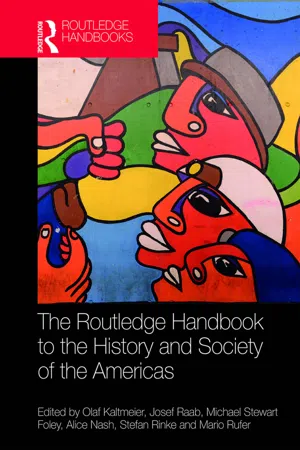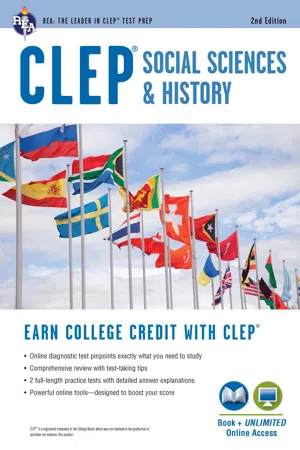History
Colonial America
Colonial America refers to the period from the early 1600s to the late 1700s when European powers, primarily England, established colonies in the Americas. These colonies were characterized by diverse economies, including agriculture, trade, and manufacturing, and were governed by a combination of local assemblies and appointed officials. The interactions between colonists, Native Americans, and enslaved Africans shaped the development of Colonial America.
Written by Perlego with AI-assistance
Related key terms
3 Key excerpts on "Colonial America"
- Olaf Kaltmeier, Josef Raab, Mike Foley, Alice Nash, Stefan Rinke, Mario Rufer(Authors)
- 2019(Publication Date)
- Routledge(Publisher)
who they were: a predominantly white population of English, Welsh, Irish, and Scottish origin, who mixed very little with the indigenous population (→ Whiteness, I/46). The slave population also kept growing, primarily in the south, where the plantation economy (first cotton and tobacco, then rice and indigo) reached a significant level of development. The absence of a landed elite facilitated a certain degree of equality among the proprietors, who became the leading political and economic agents of the new colonial society.By the mid-17th century, the colonial economy no longer belonged to the two Iberian imperial powers. Rather, America had become a part of the multilateral, international web of exchange that stretched between the shores of the Atlantic.A look into the American interior
Yet how did the American colonial economy evolve in this context? This requires looking at the other side of the equation: the generative, inwardly oriented economy, with its robust domestic markets, a feature of the Iberian (and particularly the Spanish) colonial economies that distinguished them from the settlement and plantation economies.The discovery of resources in this part of the American world gave rise to regional specialization. For that reason, zones devoted to mining and metal production can be seen (plants for mining and refining); zones with the high population needed to perform this work (mining towns); production zones to meet the needs of those populations; and zones in which the products, raw materials, and metals were bought and sold. At the same time, it was necessary to establish fixed ports to gather the metals and merchandise, and to hold annual trade fairs. Distinct commercial zones were set up for this purpose (Havana, Cartagena, Veracruz, Lima), with warehouses equipped to store the merchandise, customs to regulate it, residences for traders to stay in, and headquarters and compounds to keep guard over the merchandise and also to determine the best routes through which to distribute these colonial products to the places where they would be used. Cities were founded (Potosí, Minas Gerais), connecting the routes on which metals, merchandise, and slaves were transported from the ports to the mining towns.- eBook - ePub
- Michael Pasquier(Author)
- 2016(Publication Date)
- Routledge(Publisher)
3 RELIGION AND COLONIALISM IN EARLY AMERICA, 1400 s to 1770 s When and where does one begin a basic survey of religion in America? As we saw in the previous chapter, there’s no one answer to this question. Popular narratives often start with the Pilgrims of Plymouth Rock or the Founding Fathers of the American Revolution. Today, most scholars base the origins of American religious history in the times and places that preceded the European colonization of North America. That’s why this chapter opens with the religious worlds of Native Americans and Africans, those who would be most affected by the disruptive consequences of colonialism. We then reflect upon circumstances in Europe that fueled the imperial ambitions of Spain, France, and England to colonize what they conceived as a “New World,” a chief factor being the Protestant Reformation. The cultural collision of Native American, African, and European religions in Colonial America demonstrates the range of Catholic and Protestant responses to life during the sixteenth and seventeenth centuries. By the eighteenth century, we see how a brand of Protestantism known as evangelicalism surfaced and ultimately permeated the British colonies along the Atlantic coast, in many ways contributing to the gradual formation of a national identity with deep roots in Christianity and continued ties to Native American and African peoples. NATIVE AMERICAN RELIGIONS Native Americans played a formative role in the religious history of Colonial America. After all, somewhere between 2 million and 10 million Native Americans resided on the continent when Europeans started arriving in the fifteenth century. In his book Facing East from Indian Country (2001), the historian Daniel Richter stressed the need to understand the perspectives of Native Americans before and after they encountered European and African peoples - Scott Dittloff(Author)
- 2018(Publication Date)
- Research & Education Association(Publisher)
CHAPTER 6UNITED STATES HISTORYAMERICAN HISTORY: THE COLONIAL PERIOD (1500–1763)The Age of ExplorationThe Treaty of Tordesillas (1494) drew a line dividing the land in the New World between Spain and Portugal. Lands east of the line were Portuguese. As a result, Brazil eventually became a Portuguese colony, while Spain maintained claims to the rest of the Americas.To conquer the Americas, the Spanish monarchs used their powerful army, led by independent Spanish adventurers known as conquistadores. The European diseases they unwittingly carried with them devastated the local Native American populations, who had no immunities against such diseases.Spain administered its new holdings as an autocratic, rigidly controlled empire in which everything was to benefit the parent country. The Spaniards developed a system of large manors or estates (encomiendas), with Indian slaves ruthlessly managed for the benefit of the conquistadores. The encomienda system was later replaced by the similar but somewhat milder hacienda system. As the Indian population died from overwork and European diseases, Spaniards began importing African slaves to supply their labor needs.English and French BeginningsIn 1497, the Italian John Cabot (Giovanni Caboto, ca. 1450–1499), sailing under the sponsorship of the king of England in search of a Northwest Passage (a water route to the Orient through or around the North American continent), became the first European since the Vikings more than four centuries earlier to reach the mainland of North America, which he claimed for England. Beginning in 1534, Jacques Cartier (1491–1557), authorized by the king of France, mounted three expeditions to the area of the St. Lawrence River, which he believed might be the hoped for Northwest Passage. He explored up the river as far as the site of Montreal.
Learn about this page
Index pages curate the most relevant extracts from our library of academic textbooks. They’ve been created using an in-house natural language model (NLM), each adding context and meaning to key research topics.


